By Laura Carter //
Chris Jeppesen, Peter Mandler and I have spent most of this academic year doing research in Local Authority archives for the six regional case study areas that SESC is focusing on: North East England, North London & Hertfordshire, South West England, Scotland (Glasgow & Fife), South Wales, and Belfast. In 2018 I wrote a guide to the sources on secondary schools found in these archives, which you can read here.
I’ve been reading through log books, punishment books, PTA minutes, newspaper clippings, newsletters, and school magazines, in order to construct portraits of different secondary schools across the UK. We hope by the end of this process we’ll have around sixty individual school portraits to sit alongside our other longitudinal and oral history research, giving us a fuller picture of how schools, and the pupils who attended them, experienced social change over the postwar decades.
In this post I wanted to reflect on some sources that I’ve been finding particularly interesting in my latest archival research in South Wales and the South West (Bristol, Somerset, and Cardiff): school magazines from the 1950s to the 1970s. As far as I can tell, school magazines form an important part of understanding young people’s experiences and voices in nineteenth-century school and periodical culture in England, as well as being a source used by scholars working on democratic culture in schools in the USA and Germany, but so far not for post-1945 Britain [1]. This is kind of curious, for three reasons. Firstly, they fit into a growing body of literature on postwar British print culture and publishing as forums for diverse forms of grassroots activism. Secondly, they provide access to ‘ordinary’ pupils’ voices (although within obvious limits, see below). And thirdly, they are rich and plentiful in the archives!
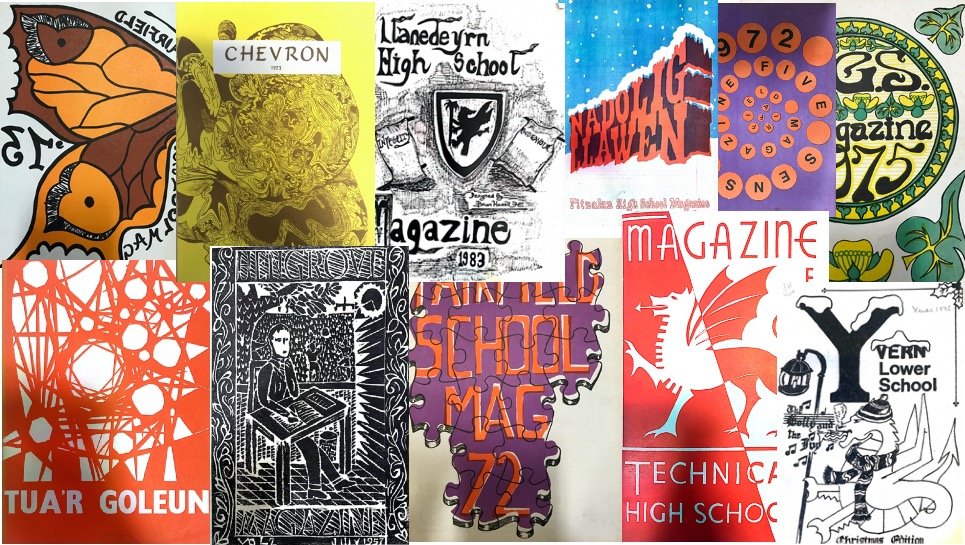
Of course, school magazines carry the burden of many cultural sources, in that they deal in representations and are not direct mirrors onto experience. However, this can be partially overcome when they are placed in dialogue with other sources from the school, community, and indeed generation in question. They are also valuable when read as discursive spaces in themselves, because their depictions of class, gender, and race tell us a lot about how institutions dealt with social change. Another objection might be that school mags are documents produced to project a certain image of the school to parents, alumni, and the wider community, telling us more about how managers and teachers sought to self-fashion the institution than about everyday life in the school. Whilst this is to some extent true for magazines produced in the grammar schools of the 1940s-1960s, which function mostly as school newsletters and the organs of Headteachers, the genre changed quite drastically from the late 1960s.
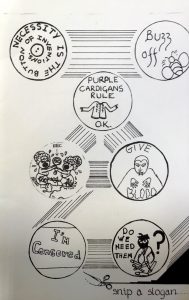
As a result of new reprographic technologies and the sheer demographics of comprehensivisation school magazines had begun to move into the hands of pupils by the early 1970s. In comps the pupil body was more diverse, yes, but these schools in the 1970s also tended to employ a minority of younger teachers who were trained and at least semi-engaged in aspects of ‘child-centred’ teaching and learning. This led to a growth in self-oriented tasks in comprehensives such as creative writing, previously associated with English primary education.
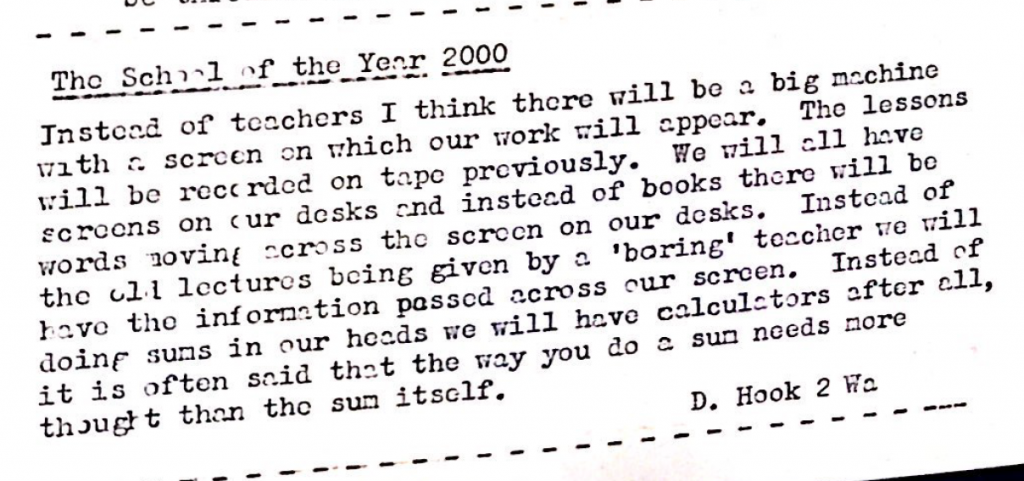
In this context, school magazines became manifestoes of pupil power and self-expression, still mediated by teachers, but clearly now vessels for a more informal and internal conversation between pupils, teachers, and parents. We hear far less ‘News of Old Pupils’ and far more of the counter school culture. Cardiff’s Llanedeyrn High School’s 1983 magazine opened with a Pink Floyd-ite editorial note declaring ‘We Don’t Need No Education…’, and that this was ‘nothing to do with the teacher-organised mag…’. Teachers were most often the target in these new school magazines. On the other side of Cardiff, at Fitzalan High School, pupils had teacher teasing down to an art by the 1970s. In this pseudo-anthropological account, a fourth-year Fitzalan pupil described the schools’ teachers as if they were tribes of ‘natives’ in a foreign land:
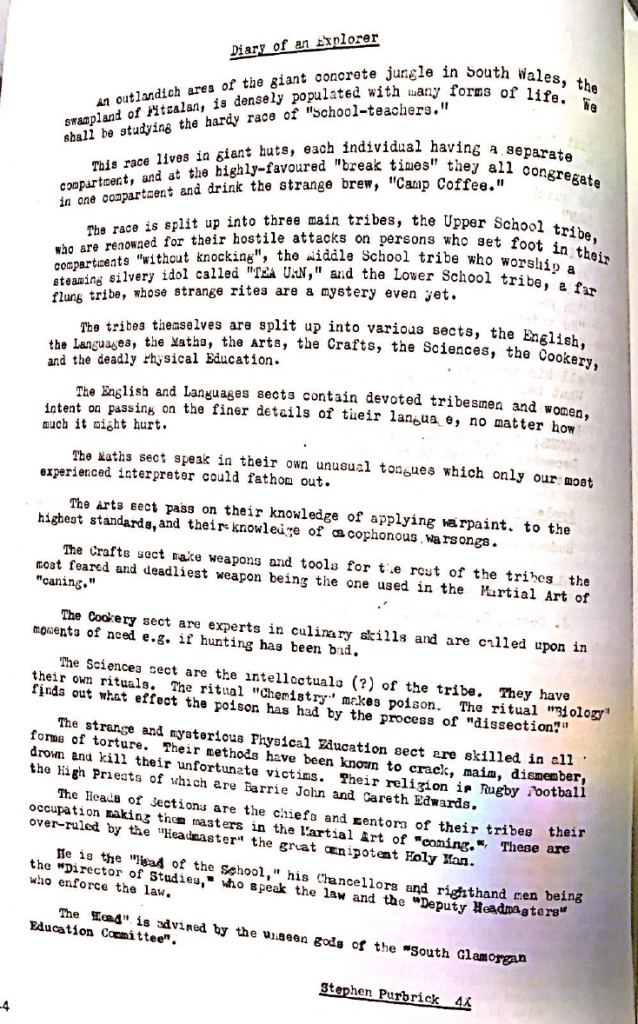
In 1969, a year before it was reorganised and amalgamated with the girls’ school, the grammar Cardiff High School for Boys had already declared its resistance to this trend in school magazines:
‘It is unfashionable these days for a Magazine to be a Record and reflection of the School that produces it. The School Magazine, say the New Men, should be the organ of Creativity, where the children can see the results of their inspiration in print; a forum for ideas and exciting discussion; the meeting-place of word and picture; a clear pointer to the intellectual state of the body it represents… It’s a wonderful world. But in these days of so much change for the sake of change, “Tua’r Goleuni” [2] continues unashamedly to be a Magazine in the old-fashioned sense’ [3].
This Cardiff contrast might slightly overstate the cultural shift bought about by comprehensivisation. I’ve read ‘50s and ‘60s grammar school magazines that also contain poetry and sometimes refer to teachers by their nicknames and secondary modern school magazines (of which fewer survive) that contain snippets of imaginative writing. But on the whole this breaking down of barriers between pupils and teachers in the 1970s found its fullest expression in co-educational comprehensive schools, a marked social shift seen clearly through the record of school mags. They contain a huge amount of visual and creative material including poetry, artwork, and advertising.
In the context of SESC’s wider agenda, I’d highlight the value of school magazines for understanding the following themes, some of which we’ve struggled to access in other source types:
Gender relations and identities in the secondary school
School magazines are peppered with references to flirtatious or romantic relations between the sexes (pupils and teachers), on school trips, in school sports, and in everyday school life. I lost count of the number of references to the hemlines of girls’ skirts, which obviously rose far quicker than the school leaving age. These instances, especially in the 1970s, are overwhelmingly conveyed via jokes, innuendo, and irony. Parents don’t escape being made fun of either, through tongue-in-check articles such as ‘A father complains about education’ and poems such as ‘A mother is…’ and a ‘A father is…’. Indeed, most school magazines from the 1970s are imbued throughout with a comic discourse, which must be read carefully given how quickly our ‘sense’ of humour changes with the cultural moment. Alongside this, pupils also write sincere poetry and prose pieces on themes such as heartbreak, loneliness, and body image, which are directly linked to the gendered expectations being reproduced in the playground and classroom. The poem below is one example. ‘The Life and Death of Size Sixteen’ was written by Amanda, a Cardiff sixth former, in 1983 and recounts a young girl’s struggle with body image and food, ending in her suicide:

Meanwhile all-boys and all-girls school magazines often remind us of the myriad ways in which gender mixing still occurred, through shared local facilities and school outings. Boys’ school magazines especially contain plentiful adverts from banks, insurance companies, and the military, in which male school leavers are constructed as the regional, technocratic elite destined to convert their ‘O’ Levels into high-status management careers:
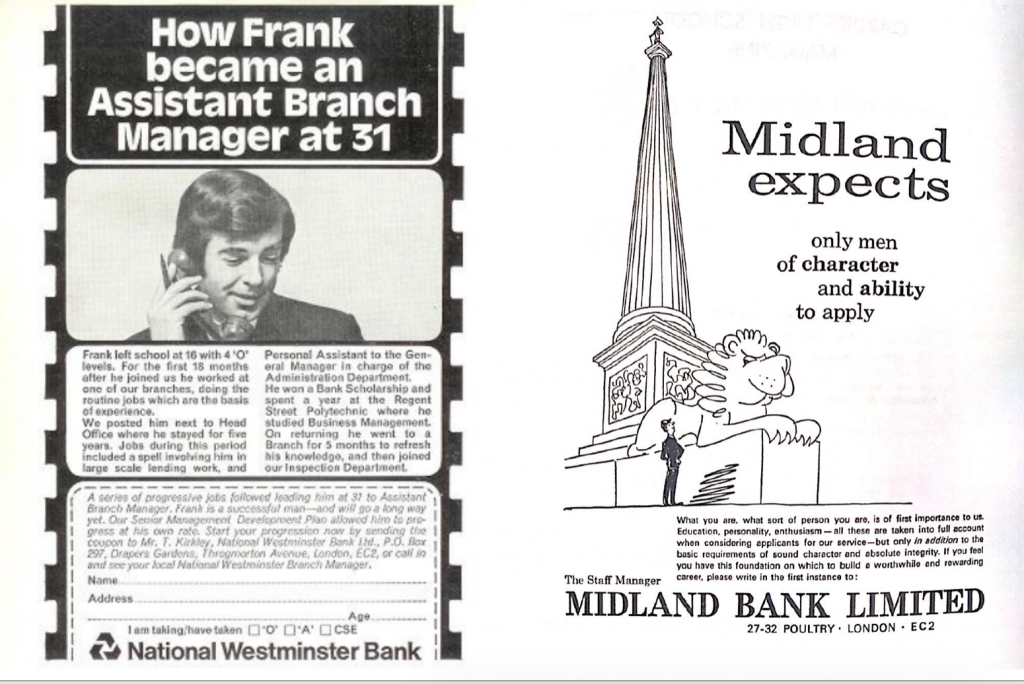
Pupil perspectives on comprehensivisation and co-education
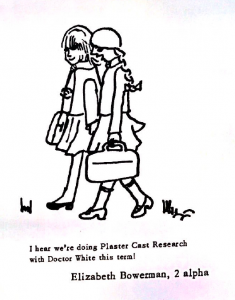
As Harry Gibbins’s oral history research on secondary school amalgamation found, going co-ed was a messy process in which girls often lost out. Looking at school magazines from schools around the period of comprehensive amalgamation, especially in the years leading up to change, can also reveal pupil expectations of the change without that retrospective lens. Headteacher editorials in the magazines of grammar schools about to be closed or merged were often tinged with remorse, but pupils were sometimes given the space in magazines to anticipate their new schools on their own terms. In line with contemporary research on co-education, pupils in the 1960s and 1970s were broadly positive about the prospect of gender mixing, and girls especially looked forward to the better resources and facilities than an education alongside boys could bring. The final magazine of Bridgwater Girls Grammar School in 1973 featured the article ‘Thoughts of a Schoolgirl in seeing the new school in Park Road’, which balanced the pain of a longer commute with the prospect of ‘proper gymnasiums’ and a new needlework room.
‘Immigrant’ voices and experiences
Recent research on the experiences of pupils of colour in British secondary education has focused on supplementary schools, churches, and black and Asian community life. It’s particularly difficult to hear from these pupils within the mainstream school system, and they are often cast as passive recipients of the widespread discrimination that existed. The school magazines that I’ve looked at from urban areas contain quite a few pieces of writing from pupils who self-identify as ethnic, national, or religious minorities. These texts need to be read as part of the problematic project of ‘multicultural’ education in schools during the 1970s and 1980s. Nonetheless, we can also try and read them against the grain to hear what these pupils are saying about their experiences. The most common format I’ve found are prose pieces by pupils reflecting on the difference between their schools overseas and their schools in Britain. For example, Sheob, a pupil at Fitzalan High School wrote an article called ‘My Village’ in the 1980s, in which he compared everyday life in Saraya, India to Cardiff:

In a different mode, Mary, a second-year pupil at Fairfield School in Bristol wrote a piece for the school magazine in 1975 asking her fellow pupils to give ‘a little bit of thought’ to the plight of Vietnamese orphans in Britain. She went on to reflect on her own experience of migration from Hong Kong to Britain, explaining ‘I find myself a bit of an exhibit, but I have never wished anything to have been different and am proud to be what I am’ [4].
Where copyright is held, the sources in this blog post have been reproduced with permission from the repositories named in the references. With thanks to Somerset Archives and Local Studies and Bristol Archives for giving us permission to reproduce this material from their collections. Where copyright has not been identified, we are happy to acknowledge any copyright holders who come forward or to remove material at their request. Please contact sesc@hist.cam.ac.uk
[1] Sonja Levsen, ‘Authority and Democracy in Postwar France and West Germany, 1945-1968’, The Journal of Modern History (2017); Catherine Sloan, ‘”Periodicals of an objectionable character”: Peers and Periodicals at Croydon Friends’ School, 1826–1875’, Victorian Periodicals Review (2017); Kathryn Gleadle, ‘Magazine Culture, Girlhood Communities, and Educational Reform in Late Victorian Britain’, The English Historical Review (2019). Many thanks to Catherine Sloan for suggestions on this literature and to Sonja Levsen for discussing the genre with me via email.
[2] ‘Tua’r Goleuni’, in Welsh, translates as ‘Towards the Light’ in English.
[3] ‘Cardiff High School for Boys Magazine’, 1968: Glamorgan Archives, Cardiff, D1418/1/10.
[4] ‘Fairfield School Magazine’, 1975: Bristol Archives, Bristol, 21131/SC/FAI/PM/4/4.
Very interesting research. I went to Dr Morgan’s Grammar School in Bridgwater, Somerset, from 1967 until 1973 when it became a comprehensive. There was a school magazine, The Morganian, that contained poems and other creative writing by the boys. The Old Morganians is a thriving group of alumni and I am sure you will find copies of the magazine through them.
Many thanks for your kind message, Roy. I’m definitely going to look that group up and see if we can see some copies of the magazine. Glad you enjoyed the blog post. – Annie
For any FUTURE researchers into Cardiff High School for Boys in the sixties, (and also Primary school education in the 50s and 60s) you might be interested in reading my website on my time at Cardiff High School for Boys, and also Grange Council Junior School (in Grangetown, Cardiff) during these periods.
You can access this site at http://cardiffhigh.tripod.com
Me and My ‘Cardiff High School for Boys’ site,
(or at least you can at the moment – 2020, but who knows in say 2050. Will Tripod still be going then?)
The contact email quoted on my site has been dead for years. but my current contact details (should you want them) is listed below.
There are, unfortunately, a couple of errors in my website text that I cannot correct as I’ve lost my access code to the site. For example, the Phil Richards quoted became a district judge, not a circuit judge, and the ‘Dwarka’ and the ‘Dumra’ never sailed into the Bay of Bengal. and I’m still trying to find out the REAl reason why George Diamond suddenly ‘ retired early’ . There were rumours, but were they true?
Ex Cardiff High School for Boys pupil 63-68
4/1/21
What a fantastic resource – thank you for sharing, Raymond.